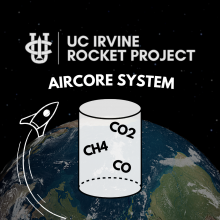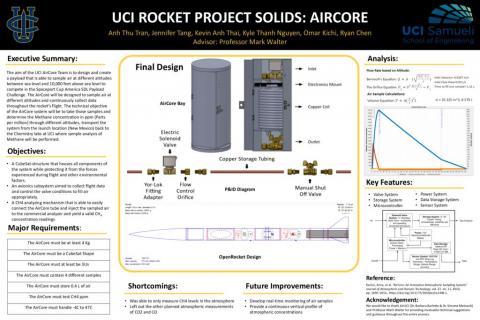UCI Rocket Project Solids: Aircore Team
Summary
UCI Rocket Project Solids Team will be building its first large collective rocket to compete in the 10k Commercial-Off-The-Shelf (COTS) Propulsion Category at the 2023 Spaceport America (SA) Cup. Our team is tasked to design an AirCore Atmospheric Sampling System that will collect and test air samples from different altitudes, allowing the team to compare the data and analyze its differences in gas concentrations. As a team, we aim to combine our interdisciplinary knowledge to meet the system requirements which include: weighing at least 4 kg, being able to withstand 10 Gs of force, be at least 3Us, ground tested, and survive 4 launch attempts. Our group aims to familiarize ourselves with the engineering design process and apply critical thinking to design a fully functional payload system for our rocket.
Background
AirCore systems are traditionally air sampling systems that are typically used to sample CO2, CH4, and CO and understand their distributions through different altitudes. This system has become much more popular through Pieter Trans and his patent of the Aircore. AirCore systems evacuate pressurized air while ascending to a chosen altitude and collects a sample from the air as it descends. The AirCore encompasses on occasion a thin long coil (~100 m) with an inlet valve accompanied with a microcontroller, GPS, and altimeter. A desiccant column is added into the system to help limit the moisture content of the air. Once the AirCore is landed, a shutoff valve is used to enclose the air that was sampled and is then stored until it is put through a continuous gas analyzer.
Typically, the analysis can show the percentages of these air samples. These systems have also been used to look into particulate matter, high-altitude radiation, temperature profiles, and pressure profiles. The analysis and the recognition of the altitude profiles are important for satellite and total column measurements but can also help with the understanding of the regional fluxes of carbon (A.Karion et al). The National Oceanic and Atmospheric Administration (NOAA) has been used to understand the North American carbon exchange. Originally, AirCore systems were just manually opened and closed by the people working; however, in order to have more accurate measurement readings, there have been more recent uses of a based active AirCore systems that open and close through a feedback loop system using altitudes and an accelerometer. These AirCore systems will help in the understanding of the effect greenhouse gasses have had on the planet’s atmosphere.
As a result, the Rocket Project can benefit from having the AirCore system built in order to compete with SDL Payload Challenge at the Space America Cup. It also aids with continuous data collecting for future ideas and projects and will also help study atmospheric profiles over a long period of time.
Goals and Objectives
The AirCore system is required to sample and compare air at two different altitudes, one sample located at sea level, and one sample located at 10,000 feet. The AirCore subsystem must be capable of sampling and holding air samples throughout the duration of the rocket launch.
By collecting data on air samples at different altitudes continuously, we can complete various studies. Our primary goal is to compare both samples’ CO2 concentrations, however, we are able to analyze other elements of the atmospheric profile, which include:
- CH4 and CO concentrations
- Ambient Air Temperature
- Atmospheric Pressure
Our timeline for our project is as follows:
- Week 1: Team Organization and Problem Definition
- Week 2: Background Research on Existing AirCore Designs
- Week 3: Concept Generation and Trade Studies
- Week 4-5: Finalize Design Decisions and Generate Bill of Materials
- Week 6-9: Critical Design of Prototype, Completing Purchase Orders
- Week 9-10: Manufacturing, Prototyping, and Testing
- Week 11: Final Presentation and Report
Future missions and team members within Rocket Project will benefit from continuous data collection from the AirCore over the years, in order to study and gain a better understanding of carbon exchanges along the atmosphere over a long period of time.
Innovation of AirCore
The aircore system with a stainless steel coil represents a major innovation in the measurement of atmospheric levels of CO2, CH4, and CO. This system provides a comprehensive understanding of the concentrations of these gasses in the atmosphere. The use of the coil allows for continuous and reliable data collection, while the aircore system provides a vertical profile of their atmospheric concentrations. This combination of materials and design provides an effective and unique solution to the challenge of measuring these gasses, making it a significant advancement in the field of atmospheric science.
External Team Website
https://www.rocket.eng.uci.edu/solids/
Team Contact
- Omar Kichi (Team Lead): okichi@uci.edu
- Ryan Chen: chenr12@uci.edu
- Kyle Thanh Nguyen: kyletn4@uci.edu
- Jennifer Tang: jennijt1@uci.edu
- Kevin Anh Thai: kathai1@uci.edu
- Anh Thu Thi Tran: attran7@uci.edu
Sponsor/Advisor
Professor Mark Walter - m.walter@uci.edu
References
Attachments


